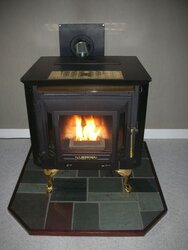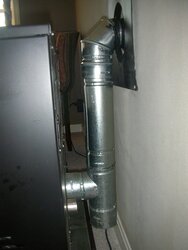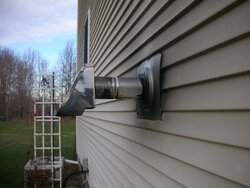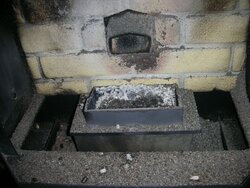I need help troubleshooting my new Jamestown J2000 pellet stove. I've tried everything I know of short of installing an OAK, which I don't even know if that will help my problem. It's gotten really cold in MA and I don't think my stove is burning as efficiently as everyone else's stove just based on reading discussion threads. Any help would be greatly appreciated!
It's a very basic install about 4 feet rise straight out the wall (I'll attach pics when I can figure it out) but no OAK. Dealer was really against it and insisted I didn't need it. Stove is new with preburn with the dealer installed end of November. It's a very basic stove which was what I wanted so none of the fancy settings like in the Harmans or Quadra Fire or Enviro. Starts up very quickly every time and burns very well or at least that's what I used to think. The flame is always a nice healthy white to yellow flame with bluish tinge in the center but can get very high when I move to higher heat setting. I've been experimenting with the draft control based on pellets. It is a new toy so excuse me with all the touching and exploring. I'm trying to find her, Betsy (yes I named my stove! Don't judge!) sweet spot and hope she'll produce the most heat for me! Haven't quite achieve that yet but with this forum and all your advice, I better be able to figure her out before the really cold weather gets here!
House:
2800+ sq ft colonial built in 2002, has good insulation and windows, fairly tight. Stove is in the livingroom on the first floor directly facing out to the front foyer and stairs. I'm not expecting to heat up my entire hourse but more as supplemental heat for the downstairs so my expectations for heating the upstairs bedrooms are pretty low.
Here's my observations about the stove/burning:
-Flame is healthy about half way up the stove on heat settings 1 and 2 with draft at 2 and auger feed at 1 (slowest I can make it). Seems to run best on setting 2 but 2 is not going to cut it when temps get down to the teens in MA. Once I push the stove to heat setting 3+, the flame gets really big, as high as the heat exchanger tubes. I don't think the flame should be that big, right?
-I've been using only "Premium" pellets. The brand used the most so far Spruce Pointes and tried out Barefoots this weekend and Okies this week due to low overnight temps. Having more difficulty burning hardwood pellets. They just do not burn very well/completely but does produce a ton of heat even when not burning completely. Pellets start to build up in burnpot within 12 hours of starting the stove on heat setting 2 to 3 and fan blowing high, auger feed rate 1.
-I've also noticed that when I push the heat setting to a 4 or 5, even with auger feed at a 1, the pellets are coming out a little faster compared to when I have the heat setting down in the 1/2 range. I'm assuming its trying to keep up with producing the higher heat so more pellets are required but I've noticed the pellets in the burnpot are not completely burned and new pellets would fall on top which starts to block up the air holes in the burnpot.
-Depending on the pellets, I have to play around with the draft setting ( A LOT!) to get the pellets to burn completely in the burnpot. I have yet to achieve complete burns with hardwood pellets. Majority of the time, I have to shut the stove down to empty out the burnpot all withing 24 hours of using the stove. Even my "completely" is no where near the burns of the Fire Gods on this forum which leads me to believe I'm not achieving maximum heat output. I would also like to burn more then 2 bags of pellets before shutting down and cleaning.
-Damper/Draft control options are 1-6. At low heat setting of 1-2, the draft is at about a 1-2 and maintains a very healthy flame. I watch the flame to make sure I'm feeding it enough air for a good burn. I usually open up the draft by increments based on the amount of buildup I see in the burnpot, usually open wide if I notice pellets starting to buildup or flame gets lazy. This strategy works with the softwoods but not so good with the hardwoods. Last night with Barefoots, had to open draft to a 6 and still pellet buildup and slow/incomplete burn which causes more pellets to build up and block the holes in the burnpot and its all downhill from there.
-ash is not ashy grey like everyone talks about, it's thicker and chunkier but I guess that happens with Softwood but doesn't explain why I don't have any grey fly ash in the stove especially when burning hardwood pellets.
-pretty much every time I stop the stove to clean/scrape the burnpot, I've vacuumed the inside,clean the glass and empty out the ash pan. This has been averaging almost once a day. The longest time I went without cleaning/vacumming was 2.5 days using Spruce Pointes with a lot of manual draft adjustment even using the same pellet. All the other times its been about 12-24 hours of usage before shutdown to clean. I'm ready and willing to clean my stove but just thought it could burn a little longer then 12-24 hours before each cleaning.
I read on this forum that people are burning 7-10 bags before they even consider cleaning, and in some cases even longer! I'm doing something very wrong if I'm cleaning almost every day and still have pellet build up due to slow burn! Is not having an OAK the issue? I'm thinking I might have an air flow issue if my pellets are not burning completely. I've opened up the draft completely and that's helped some but I have no where to go from a 6! What else should I be doing? I'm burning the best pellets I can find and still not having half the results. What do you guys think? Air flow? Crappy stove? Crappy install? Bad pellets? It's NOT dirty! I'm nuts over keeping a clean stove! All ideas/suggestions are welcomed! Just don't be too harsh! I'm trying to learn! THANKS!
It's a very basic install about 4 feet rise straight out the wall (I'll attach pics when I can figure it out) but no OAK. Dealer was really against it and insisted I didn't need it. Stove is new with preburn with the dealer installed end of November. It's a very basic stove which was what I wanted so none of the fancy settings like in the Harmans or Quadra Fire or Enviro. Starts up very quickly every time and burns very well or at least that's what I used to think. The flame is always a nice healthy white to yellow flame with bluish tinge in the center but can get very high when I move to higher heat setting. I've been experimenting with the draft control based on pellets. It is a new toy so excuse me with all the touching and exploring. I'm trying to find her, Betsy (yes I named my stove! Don't judge!) sweet spot and hope she'll produce the most heat for me! Haven't quite achieve that yet but with this forum and all your advice, I better be able to figure her out before the really cold weather gets here!
House:
2800+ sq ft colonial built in 2002, has good insulation and windows, fairly tight. Stove is in the livingroom on the first floor directly facing out to the front foyer and stairs. I'm not expecting to heat up my entire hourse but more as supplemental heat for the downstairs so my expectations for heating the upstairs bedrooms are pretty low.
Here's my observations about the stove/burning:
-Flame is healthy about half way up the stove on heat settings 1 and 2 with draft at 2 and auger feed at 1 (slowest I can make it). Seems to run best on setting 2 but 2 is not going to cut it when temps get down to the teens in MA. Once I push the stove to heat setting 3+, the flame gets really big, as high as the heat exchanger tubes. I don't think the flame should be that big, right?
-I've been using only "Premium" pellets. The brand used the most so far Spruce Pointes and tried out Barefoots this weekend and Okies this week due to low overnight temps. Having more difficulty burning hardwood pellets. They just do not burn very well/completely but does produce a ton of heat even when not burning completely. Pellets start to build up in burnpot within 12 hours of starting the stove on heat setting 2 to 3 and fan blowing high, auger feed rate 1.
-I've also noticed that when I push the heat setting to a 4 or 5, even with auger feed at a 1, the pellets are coming out a little faster compared to when I have the heat setting down in the 1/2 range. I'm assuming its trying to keep up with producing the higher heat so more pellets are required but I've noticed the pellets in the burnpot are not completely burned and new pellets would fall on top which starts to block up the air holes in the burnpot.
-Depending on the pellets, I have to play around with the draft setting ( A LOT!) to get the pellets to burn completely in the burnpot. I have yet to achieve complete burns with hardwood pellets. Majority of the time, I have to shut the stove down to empty out the burnpot all withing 24 hours of using the stove. Even my "completely" is no where near the burns of the Fire Gods on this forum which leads me to believe I'm not achieving maximum heat output. I would also like to burn more then 2 bags of pellets before shutting down and cleaning.
-Damper/Draft control options are 1-6. At low heat setting of 1-2, the draft is at about a 1-2 and maintains a very healthy flame. I watch the flame to make sure I'm feeding it enough air for a good burn. I usually open up the draft by increments based on the amount of buildup I see in the burnpot, usually open wide if I notice pellets starting to buildup or flame gets lazy. This strategy works with the softwoods but not so good with the hardwoods. Last night with Barefoots, had to open draft to a 6 and still pellet buildup and slow/incomplete burn which causes more pellets to build up and block the holes in the burnpot and its all downhill from there.
-ash is not ashy grey like everyone talks about, it's thicker and chunkier but I guess that happens with Softwood but doesn't explain why I don't have any grey fly ash in the stove especially when burning hardwood pellets.
-pretty much every time I stop the stove to clean/scrape the burnpot, I've vacuumed the inside,clean the glass and empty out the ash pan. This has been averaging almost once a day. The longest time I went without cleaning/vacumming was 2.5 days using Spruce Pointes with a lot of manual draft adjustment even using the same pellet. All the other times its been about 12-24 hours of usage before shutdown to clean. I'm ready and willing to clean my stove but just thought it could burn a little longer then 12-24 hours before each cleaning.
I read on this forum that people are burning 7-10 bags before they even consider cleaning, and in some cases even longer! I'm doing something very wrong if I'm cleaning almost every day and still have pellet build up due to slow burn! Is not having an OAK the issue? I'm thinking I might have an air flow issue if my pellets are not burning completely. I've opened up the draft completely and that's helped some but I have no where to go from a 6! What else should I be doing? I'm burning the best pellets I can find and still not having half the results. What do you guys think? Air flow? Crappy stove? Crappy install? Bad pellets? It's NOT dirty! I'm nuts over keeping a clean stove! All ideas/suggestions are welcomed! Just don't be too harsh! I'm trying to learn! THANKS!






 I thought Spruce Pointes were great but these Barefoots are amazing!
I thought Spruce Pointes were great but these Barefoots are amazing!